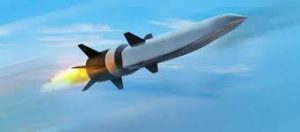19 Oct Hypersonic Missile

- Recently, it has been reported that China tested a nuclear-capable hypersonic glide vehicle that circled the globe before speeding towards its target.
- Several countries, including the US, Russia and China, are developing hypersonic missiles which travel at a speed five times that of sound.
- Though slower than ballistic missiles, they are harder to intercept and can be manoeuvred.
Implications for India:
- Hypersonic technology developments, in the backdrop of growing US-China rivarly and a year-long Standoff with Indian forces in eastern Ladakh, is certainly a threat for India’s space assets along with the surface assets. The offence system operating at these speeds would mean a requirement to develop defence systems at these speeds.
Hypersonic Speed and Technology:
- Hypersonic speeds are 5 or more times the Mach or speed of sound.
- Mach Number: It describes an aircraft’s speed compared with the speed of sound in air, with Mach 1 equating to the speed of sound i.e. 343 metre per second.
Types (2):
Hypersonic cruise missiles: These are the ones that use rocket or jet propellant through their flight and are regarded as being just faster versions of existing cruise missiles.
Hypersonic Glide Vehicle (HGV): These missiles first go up into the atmosphere on a conventional rocket before being launched towards their target.
Technology Used: Most hypersonic vehicles primarily use thescramjet technology, which is a type of Air Breathing propulsion System.
This is extremely complex technology, which also needs to be able to handle high temperatures, making the hypersonic systems extremely costly.
Ballistic Missile vs Cruise Missile
| Ballistic Missile | Cruise Missile |
| § Travel in projectile motion and trajectory depends on gravity, air resistance and Coriolis Force. | § Comparatively follows a straight trajectory of motion. |
| § Leave the earth’s atmosphere and re enter it. | § The flight path is within the earth’s atmosphere. |
| § Long-range missiles (300 km to 12,000 km) | § Short range missiles (range upto 1000 km) |
| § E.g. Prithvi I, Prithvi II, Agni I, Agni II and Dhanush missiles. | § E.g. BrahMos missiles |
Classification of Missiles Based on Speed
| Speed Range | Mach Number | Velocity in m/s |
| Subsonic | < 0.8 | < 274 |
| Transonic | 0.8–1.2 | 274–412 |
| Supersonic | 1.2–5 | 412–1715 |
| Hypersonic | 5–10 | 1715–3430 |
| High-hypersonic | 10–25 | 3430–8507 |
Development of Hypersonic Technology in India:
- India, too, is working on hypersonic technologies.
- As far as space assets are concerned, India has already proved its capabilities through the test of ASAT under Mission Shakti.
- Hypersonic technology has been developed and tested by both DRDO and ISRO.
- Recently, DRDO has successfully flight-tested the Hypersonic Technology Demonstrator Vehicle (HSTDV), with a capability to travel at 6 times the speed of sound.
- Also, a Hypersonic Wind Tunnel(HWT) test facility of the DRDO was inaugurated in Hyderabad. It is a pressure vacuum-driven, enclosed free jet facility that simulates Mach 5 to 12.
Air Breathing Propulsion System
- These systems use atmospheric oxygen, which is available up to about 50 km of earth’s surface to burn the fuel stored on-board thereby making the system much lighter, more efficient and cost effective.
- Examples of Air Breathing Propulsion System include the Ramjet, Scramjet, Dual Mode Ramjet (DMRJ).
Ramjet:
- A ramjet is a form of air breathing jet engine that uses the vehicle’s forward motion to compress incoming air for combustion without an axial compressor.
- Fuel is injected in the combustion chamber where it mixes with the hot compressed air and ignites.
- Ramjets cannot produce thrust at zero airspeed; they cannot move an aircraft from a standstill.
- A ramjet-powered vehicle, therefore, requires an assisted take-off, like a rocket assist, to accelerate it to a speed where it begins to produce thrust.
- The ramjet works best at supersonic speeds and as the speed enters the hypersonic range, its efficiency starts to drop.
Scramjet:
- A scramjet engine is an improvement over the ramjet engine as it operates at hypersonic speeds and allows supersonic combustion, which gives it its name — supersonic combustion ramjet, or scramjet.
The scramjet is composed of three basic components:
- A converging inlet where incoming air is compressed,
- A combustor where gaseous fuel is burned with atmospheric oxygen to produce heat,
- A diverging nozzle where the heated air is accelerated to produce thrust. The exhaust gases are accelerated to hypersonic speeds using a divergent nozzle.
- The speed at which the vehicle moves through the atmosphere causes the air to compress within the inlet. As such, no moving parts are needed in a scramjet, which reduces the weight and the number of failure points in the engine.
Dual Mode Ramjet (DMRJ):
- The third concept is a mix of ramjet and scramjet, which is called DMRJ.
- There is a need for an engine which can operate at both supersonic and hypersonic speeds.
- A DMRJ is an engine design where a ramjet transforms into a scramjet over Mach 4-8 range, which means, it can operate in both the subsonic and supersonic combustor mode.
yojna ias daily current affairs 19 Oct 2021


No Comments